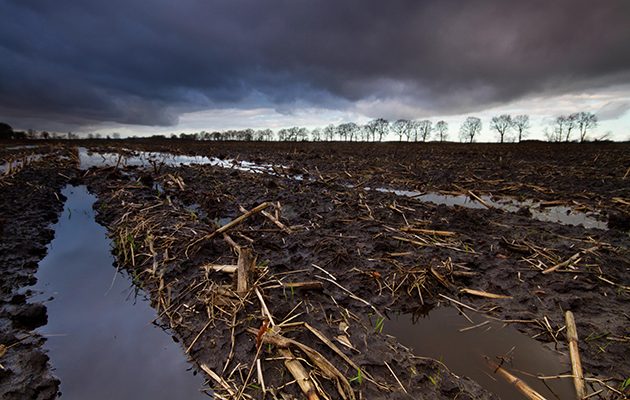Autumn maize crops for feed or anaerobic digestion leave land vulnerable to environmental damage, says Tim Field. However, cover crops and buffer strips can benefit farms and shoots
Growing maize has tripled since the 1990s, giving large yields of high-energy crop for feed or anaerobic digestion. But the muddy fields come October are the signs of serious consequences, says Tim Field.
For more on farming, read sustainable seafood production: buy one set one free.
GROWING MAIZE
Getting stuck in mud over the axles demonstrates nature’s challenge to machines. The perfect storm for mud-wallowing tractors occurs during seasonally dreadful weather on bare ground bound loosely by a superficial root structure. The autumn maize harvest has it all, with 20 tonnes of machinery providing scope for humiliation.
Sown in spring, an old American adage benchmarks a good maize crop as “knee high by the fourth of July” but advances in breeding make thigh or even waist high not unusual. With pre-emergence herbicides to keep weeds at bay and bolstered by a dose of mineral fertiliser, maize gives large yields of a high-energy crop that is attractive for forage production – not just for 365-day housed dairying but also as a buffer and complement to grass-fed systems. The land area put down to maize has tripled since the 1990s but, sadly, October mud wallowing typifies rather more serious consequences.
The siltation of our waterways from excessive runoff and correlating nitrate and phosphate spikes has long been a concern for the Environment Agency, fisheries and water companies. Their associated organisations are increasingly taking steps to keep the mud and fertility on the fields and maize is an obvious target. While the fast-growing, carbon-storing stand is ideal through the summer, the disturbance of a late, wet harvest leaves the field vulnerable to soil damage. This was exemplified by a Pembrokeshire farm I visited on a shoot last January. Saturated from compaction it was crossed by incising tyre marks, had thin, patchy soils revealing shale screed and a noticeable absence of organic matter. Top soil had been deposited on the bed of once-thriving spawning redds in the valley’s stream. Aside from the environmental impacts of poorly managed maize, there is anecdotal evidence that links tuberculosis with maize-fed cattle that lack certain minerals and a significant difference in meat and dairy nutritional quality to that which is pasture-fed.
On a positive note, there are measures that can be put in place to mitigate or lessen the environmental impact of growing maize under adverse conditions. The Campaign for the Farmed Environment provides a suite of options, including under-sowing and cover crops, buffer strips, early harvest varieties and specific cultivation techniques.
The recent rise in maize growing is not only attributed to feeding livestock, as maize has become a regular feedstock for anaerobic digestion (AD). Farmers are well placed to mitigate climate change through managing emissions and generating green energy and AD can achieve both these by diverting animal and food waste, and supplying the national grid. However, farm systems can struggle to get viable gas yields solely from on-farm waste so are encouraged to grow maize to enrich the feedstock – or even replace it entirely. There is a certain irony with the use of fossil-fuel derived nitrogen fertilisers applied to feedstock maize; a case of robbing Peter to pay Paul. That said, maize stubbles can benefit from an application of the digestate, a by-product of AD. Digestate is an excellent fertiliser and soil conditioner but the window to spread is restricted while the crop stands thus it is stockpiled and spread whenever possible after harvest in October. Poor timing substantially increases environmental risks in the catchment.
In 2013, the NFU laid down ambitions for a thousand AD units by 2020; with 277 operational as of June 2017, there is still scope for rapid growth in the industry. The NFU suggested 100,000 to 125,000 hectares of maize would be required to fulfil this goal. It raises debates of fuel over food security, with the same area capable of producing one million tonnes of wheat or more than 5.5 million tonnes of potatoes. Meanwhile, we are threatened by a hike in farmland value and degradation of the environment. With regard to food security, surely we should consider the estimated 30% of UK food that gets wasted, most of which is viable AD feedstock and comes with a welcome payment for disposal. AD plants do need to be considered like a giant living stomach – and with all stomachs, too much “junk” food can result in unwelcome rumbles and gurgles.
A more stable source of feedstock helps to buffer the inconsistencies of food-waste streams. Our local Agrivert AD plant at Oxford has a valuable synergy between its livestock holding and grass growing for the farm. The perennial grass leys have good soil structure to receive AD digestate through the winter and the benefits were evident in spring – their grass was twice the height of ours. The ensiled grass provides a 365-day buffer for the predominantly food-waste input while supporting livestock, better soil structure and a good chance of avoiding mud-wallowing forage harvesters.
Follow Tim and Agricology @agricology





